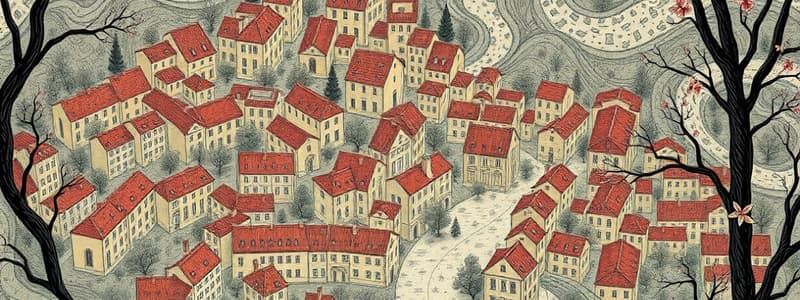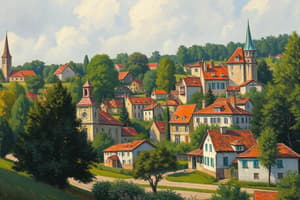Podcast
Questions and Answers
Which factor is NOT mentioned as impacting population distribution?
Which factor is NOT mentioned as impacting population distribution?
- Drainage
- Relief
- Industry
- Climate (correct)
Swamps are known to support high population densities without reclamation.
Swamps are known to support high population densities without reclamation.
False (B)
Name one area in Jamaica associated with high population density due to industry.
Name one area in Jamaica associated with high population density due to industry.
Kingston
The development of ____ mining has attracted well-paid workers to areas in Jamaica.
The development of ____ mining has attracted well-paid workers to areas in Jamaica.
Match the following areas to their associated industries influencing population density:
Match the following areas to their associated industries influencing population density:
What is the primary reason government planners study population?
What is the primary reason government planners study population?
Population distribution tends to be evenly spread across regions globally.
Population distribution tends to be evenly spread across regions globally.
How often is the population census conducted by the Statistical Institute of Jamaica?
How often is the population census conducted by the Statistical Institute of Jamaica?
Population density is calculated as the number of people per square ________.
Population density is calculated as the number of people per square ________.
Match the following factors with their influence on population distribution:
Match the following factors with their influence on population distribution:
Which parish is described as having the most compact population distribution?
Which parish is described as having the most compact population distribution?
Urban areas typically have lower population densities compared to rural areas.
Urban areas typically have lower population densities compared to rural areas.
Name an area in Jamaica that is least populated and provide one reason why.
Name an area in Jamaica that is least populated and provide one reason why.
Which of the following factors is NOT a reason why people live in settlements?
Which of the following factors is NOT a reason why people live in settlements?
Public services are more readily available in small villages than in large towns.
Public services are more readily available in small villages than in large towns.
What is the name of the branch of Geography that population falls under?
What is the name of the branch of Geography that population falls under?
The study of population is termed __________.
The study of population is termed __________.
Match the following terms related to population with their correct explanations:
Match the following terms related to population with their correct explanations:
Which agency is responsible for conducting the census in Jamaica?
Which agency is responsible for conducting the census in Jamaica?
Larger settlements typically have a wider range of jobs available compared to smaller settlements.
Larger settlements typically have a wider range of jobs available compared to smaller settlements.
Name two factors that influence population distribution.
Name two factors that influence population distribution.
Flashcards
Impact of Industry on Population Density
Impact of Industry on Population Density
Industries create jobs, higher wages, and better living conditions, leading to higher population density in areas with industrial development.
Population Density Impact of Relief
Population Density Impact of Relief
Areas with difficult terrain (hilly, mountainous) tend to have lower population densities compared to flat areas due to challenges in accessing resources and building infrastructure.
Population Density Impact of Drainage
Population Density Impact of Drainage
Areas with poor drainage (flooding, swamps) offer less attractive conditions for settlement, leading to lower population densities. Conversely, well-drained areas might support high density.
High Population Density Areas
High Population Density Areas
Signup and view all the flashcards
Low Population Density Areas
Low Population Density Areas
Signup and view all the flashcards
Population
Population
Signup and view all the flashcards
Population Distribution
Population Distribution
Signup and view all the flashcards
Population Density
Population Density
Signup and view all the flashcards
Human Geography
Human Geography
Signup and view all the flashcards
Demography
Demography
Signup and view all the flashcards
Census
Census
Signup and view all the flashcards
Jamaica Census Agency
Jamaica Census Agency
Signup and view all the flashcards
Settlement
Settlement
Signup and view all the flashcards
Population Density Calculation
Population Density Calculation
Signup and view all the flashcards
Factors influencing Population Distribution
Factors influencing Population Distribution
Signup and view all the flashcards
Lowlands (settlements)
Lowlands (settlements)
Signup and view all the flashcards
Steep Slopes/Mountains (settlements)
Steep Slopes/Mountains (settlements)
Signup and view all the flashcards
Poorly Drained Areas
Poorly Drained Areas
Signup and view all the flashcards
Why Study Population?
Why Study Population?
Signup and view all the flashcards
Study Notes
Settlement Types
- A settlement is a place where people live, categorized as either urban or rural.
- Rural settlements are located in the countryside, including villages and small towns.
- Urban settlements are towns or cities with better transport links, services, and entertainment facilities due to higher population density.
Settlement Patterns
- Dispersed/scattered settlement: Isolated houses spread over a large area, often in agricultural, rural, or hilly regions.
- Linear settlement: Buildings in a line along a roadway, rivers, or coastlines.
- Nucleated settlement: Buildings clustered together, typically at the intersection of roads or on flat/gentle sloping land.
Why People Live in Settlements
- Employment: Small settlements offer limited jobs, mostly in agriculture, while larger settlements offer a wider variety of jobs. People often move from rural to urban areas to find better employment opportunities.
- Public services: Public services like schools, hospitals, post offices, and police stations are expensive to provide in small settlements and are often unavailable. Therefore, people gravitate to larger settlements with better access to comprehensive public services.
- Infrastructure: Large settlements usually have better infrastructure, including roads, water supply, electricity, telephone services, and ports, making them more attractive to live in.
- Recreational facilities: Larger settlements often have more recreational facilities such as sports fields, cinemas, restaurants, and clubs.
Population
- Population refers to the total number of people residing in a specific area.
- Human Geography: is the branch of geography that studies population.
- Demography: is the study of human populations.
- Census: is a method of collecting data on population in a region.
- Statistical Institute of Jamaica: The government agency responsible for conducting the census in Jamaica.
- The census is conducted every 10 years.
- Government planners use population data to prepare for future needs, like infrastructure development (schools, hospitals, and roads.)
- Studying population helps identify and train skilled human resources for a country's growth.
Population Distribution
- Population distribution refers to how people are spread out across a region.
- Population distribution is uneven globally, regionally, and nationally, and it changes over time.
Population Density
- Population density is the number of people in a specific area.
- Density is calculated by dividing the total population by the area.
- Population density varies across different locations reflecting diverse geographical factors like terrain, resources, and economic activities.
Factors Influencing Population Distribution
- Relief: Lowlands are more attractive for settlement due to easier road and building construction (e.g., Kingston City). Conversely, steep slopes and mountains are more challenging for settlements.
- Drainage: Poorly drained areas like swamps and marshes often have sparse populations due to difficulties with building foundations and spread of diseases (e.g. swampy lowlands of Portmore).
- Industry: Industries attract people seeking job opportunities, higher earnings, and higher standards of living, thus leading to high population density in areas with significant industries. (e.g., Kingston and Spanish Town - high population, due to industries).
Studying That Suits You
Use AI to generate personalized quizzes and flashcards to suit your learning preferences.
Related Documents
Description
Explore the different types and patterns of settlements, including urban and rural classifications. Understand the reasons people choose to live in specific areas and how these settlements are structured. This quiz will test your knowledge on scattered, linear, and nucleated settlements.




